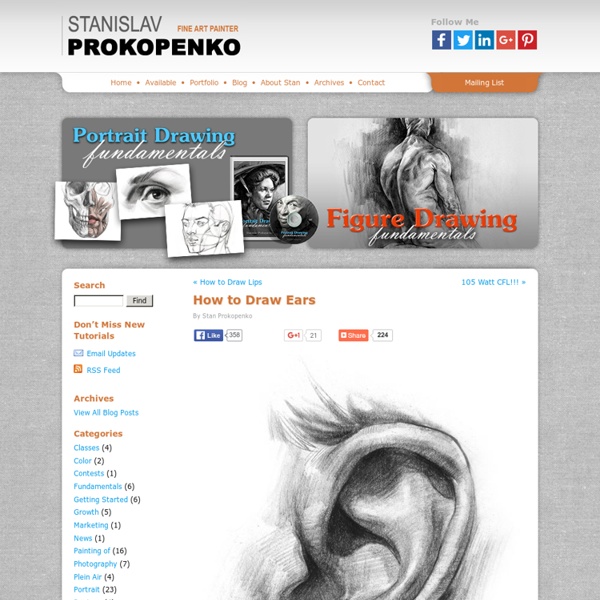How to Think of What to Draw
Edit Article Edited by Dvortygirl, Laptop123, Nicole Willson, Random and 41 others Have you been inspired to draw, including getting inspiration from famous artists, or are just doing it for fun?
Drawing Hands
This short tutorial is a just a small taste of a larger and much more in-depth book I wrote called The Mad Art of Caricature! The book is 175 full-color pages, lavishly illustrated and contains greatly expanded explanations of the concepts presented in this tutorials, as well and a great deal of additional material on caricaturing other facial features, posture, hands, expression and more, techniques on drawing from live models, doing caricature for freelance illustration and for MAD Magazine. This is a must have book for anyone interested in caricature, cartooning or humorous illustration.
How to draw the face - Portrait Art Tutorials, lessons on portrait art basics.
This book is highly (and frequently) recommended on this site."The New Drawing on the Right Side of the Brain" by Betty Edwards shows how anyone can learn how to draw, even if they think they have no "talent." (If you are in the UK, look for this book on Amazon.co.uk.) One of my favorite art teachers was a student of Betty Edwards, and he taught her method in his class.
Sketches by Spencer Nugent
Home Contact Link Sketch Archive Sketch-A-Day on Facebook.com
How to Draw the Nose
Update 09-26-2012 – Above is a video version of this tutorial. For more video tutorials visit Proko.com and subscribe to the newsletter In this tutorial I will go over the structure of the nose and give detailed information about the bridge, ball, and nostrils of the nose. At the end, I will show a step by step of a nose drawing. The Major Planes
Lucid Dreaming Frequently Asked Questions Answered by The Lucidity Institute
Version 2.4 © Lucidity Institute (contact us) This FAQ is a brief introduction to lucid dreaming: what it is, how to do it, and what can be done with it. There are several excellent sources of information on lucid dreaming, the most reliable and extensive of which is the Lucidity Institute website ( Other sources are listed below. Stephen LaBerge presents workshops, and training programs for learning lucid dreaming.
Make Watercolor and Marker Style Portraits with Illustrator
With this tutorial, we are going to work through ways of creating digital portrait illustrations that have a unique and somewhat tactile feel of marker and watercolor. This tutorial will focus on using a drawing tablet and Adobe Illustrator. There will be a focus on technique and technical settings, but the overall product will rely on your own personal style and taste. Preview Resources
Miles Waterhouse - Fine Art style truck painting tutorial
Website design and creation by Allan Macdonald. All rights reserved. Contact: info@designertechniques.com Using tonal variations of the background a textured brush is used to form the rear of the truck cab. Since the light source has been decided some is cast onto the ground and onto the wheel detail. Having decided that this proposal needs even more attitude, some aggressive graphics are put in which will also contain the headlamps.
How to Draw the Head From Any Angle
The Basic Forms To draw the head from any angle you must first understand its basic structure. Look past all the distracting details and visualize the underlying forms. This ability to simplify can be applied to the features of the face, but when starting the drawing you could look even further. Ignore even the features and simplify to the most basic form of the head.
Color Psychology
by David Johnson Like death and taxes, there is no escaping color. It is ubiquitous.
Musings and articles: How to hold the pencil
The least frequently asked question about drawing is “How do you hold the pencil?” Most people are simply unaware that there is more than one way to hold it. They unconsciously use the writing pen grip they learned in elementary school, and it does not occur to them to even think of changing it. Yet many typical beginner’s problems with pencil drawing, from wobbliness to hatched lines, originate from bad grip.
Realistic Eyes
Have trouble drawing eyes? Well, you’re probably not alone. Eyes are the first thing that the viewer is drawn to in a portrait.
Pencil Portrait Lessons
In the last lesson on eyes we talked about the various problems that artists run into when trying to draw eyes as realistic as possible. In this lesson, we will begin the drawing process. There are two things that you need to do in order to in order to get started. The first is to make sure you are using the right tools. If you have trouble finding the tools locally, or if you would simply like to help support this site, you can purchase the tools directly from my Shopping Center by clicking on the Pencil Portrait Supplies link in the upper left section of this page.
What is your body language saying?
Narrowing the red margins of your lips is a clear sign of anger, while massaging your forehead can signal uneasiness. Brushing hair off your face is a combination of nerves and flirtationIf you nod in clusters of three, the speaker will sense your interestStuffing your hands in your pockets means you're probably hiding somethingIn a seated conversation, lifting your toes means your feelings are extra-positive (RealSimple.com) -- Every last gesture -- whether it's a tilt of the head or plain fidgeting -- tells a story. Do you look down when you speak? Play with your hair?



